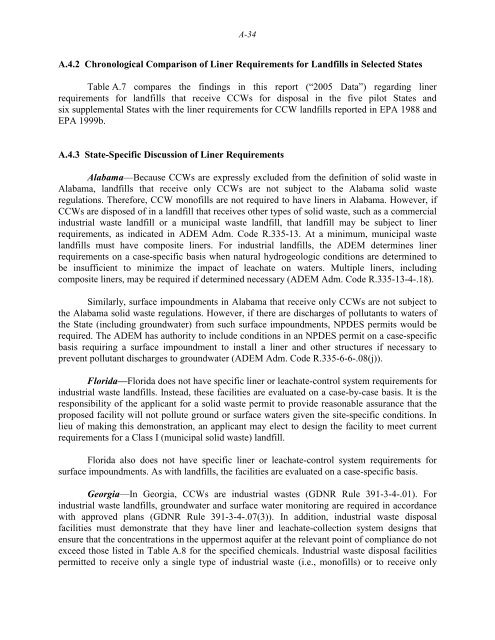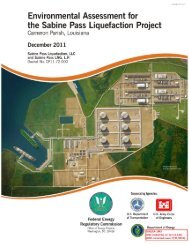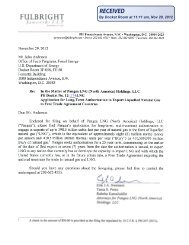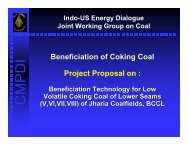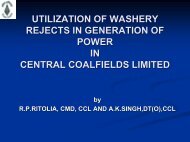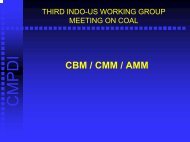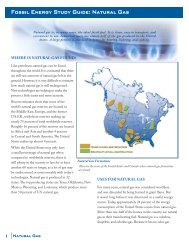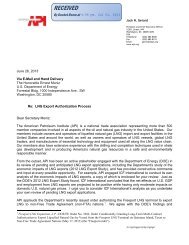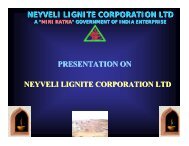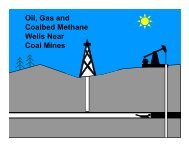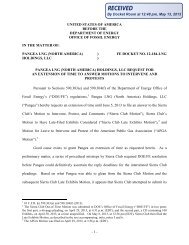Coal Combustion Waste Management at - DOE - Fossil Energy ...
Coal Combustion Waste Management at - DOE - Fossil Energy ...
Coal Combustion Waste Management at - DOE - Fossil Energy ...
You also want an ePaper? Increase the reach of your titles
YUMPU automatically turns print PDFs into web optimized ePapers that Google loves.
A-34<br />
A.4.2 Chronological Comparison of Liner Requirements for Landfills in Selected St<strong>at</strong>es<br />
Table A.7 compares the findings in this report (“2005 D<strong>at</strong>a”) regarding liner<br />
requirements for landfills th<strong>at</strong> receive CCWs for disposal in the five pilot St<strong>at</strong>es and<br />
six supplemental St<strong>at</strong>es with the liner requirements for CCW landfills reported in EPA 1988 and<br />
EPA 1999b.<br />
A.4.3 St<strong>at</strong>e-Specific Discussion of Liner Requirements<br />
Alabama—Because CCWs are expressly excluded from the definition of solid waste in<br />
Alabama, landfills th<strong>at</strong> receive only CCWs are not subject to the Alabama solid waste<br />
regul<strong>at</strong>ions. Therefore, CCW monofills are not required to have liners in Alabama. However, if<br />
CCWs are disposed of in a landfill th<strong>at</strong> receives other types of solid waste, such as a commercial<br />
industrial waste landfill or a municipal waste landfill, th<strong>at</strong> landfill may be subject to liner<br />
requirements, as indic<strong>at</strong>ed in ADEM Adm. Code R.335-13. At a minimum, municipal waste<br />
landfills must have composite liners. For industrial landfills, the ADEM determines liner<br />
requirements on a case-specific basis when n<strong>at</strong>ural hydrogeologic conditions are determined to<br />
be insufficient to minimize the impact of leach<strong>at</strong>e on w<strong>at</strong>ers. Multiple liners, including<br />
composite liners, may be required if determined necessary (ADEM Adm. Code R.335-13-4-.18).<br />
Similarly, surface impoundments in Alabama th<strong>at</strong> receive only CCWs are not subject to<br />
the Alabama solid waste regul<strong>at</strong>ions. However, if there are discharges of pollutants to w<strong>at</strong>ers of<br />
the St<strong>at</strong>e (including groundw<strong>at</strong>er) from such surface impoundments, NPDES permits would be<br />
required. The ADEM has authority to include conditions in an NPDES permit on a case-specific<br />
basis requiring a surface impoundment to install a liner and other structures if necessary to<br />
prevent pollutant discharges to groundw<strong>at</strong>er (ADEM Adm. Code R.335-6-6-.08(j)).<br />
Florida—Florida does not have specific liner or leach<strong>at</strong>e-control system requirements for<br />
industrial waste landfills. Instead, these facilities are evalu<strong>at</strong>ed on a case-by-case basis. It is the<br />
responsibility of the applicant for a solid waste permit to provide reasonable assurance th<strong>at</strong> the<br />
proposed facility will not pollute ground or surface w<strong>at</strong>ers given the site-specific conditions. In<br />
lieu of making this demonstr<strong>at</strong>ion, an applicant may elect to design the facility to meet current<br />
requirements for a Class I (municipal solid waste) landfill.<br />
Florida also does not have specific liner or leach<strong>at</strong>e-control system requirements for<br />
surface impoundments. As with landfills, the facilities are evalu<strong>at</strong>ed on a case-specific basis.<br />
Georgia—In Georgia, CCWs are industrial wastes (GDNR Rule 391-3-4-.01). For<br />
industrial waste landfills, groundw<strong>at</strong>er and surface w<strong>at</strong>er monitoring are required in accordance<br />
with approved plans (GDNR Rule 391-3-4-.07(3)). In addition, industrial waste disposal<br />
facilities must demonstr<strong>at</strong>e th<strong>at</strong> they have liner and leach<strong>at</strong>e-collection system designs th<strong>at</strong><br />
ensure th<strong>at</strong> the concentr<strong>at</strong>ions in the uppermost aquifer <strong>at</strong> the relevant point of compliance do not<br />
exceed those listed in Table A.8 for the specified chemicals. Industrial waste disposal facilities<br />
permitted to receive only a single type of industrial waste (i.e., monofills) or to receive only


